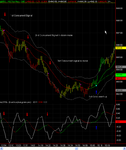Fastnet,
Call Chick directly and ask him to help you. He can clear up your question alot quicker than I can online here. I do not have time to write a great explanation for you. But while I am here I will say this: One of the tricks/techniques he is doing is simply looking ahead by looking back to where the ML is taking off high or low numbers. You can do this with any indicator.
He simply anticipating the next trend in the middle line. By looking back to where the SL was 10-16 days ago. You can get an idea of where the price would have to close to put you into the next uptrend in the ML. You should know the construction of the lines cold (at least the ones you choose to trade with). The middle line he uses is more trendy than price (in my 10 years experience with it I agree --look at the charts left on this link). Which is odd because the Middle Line is twice removed from price. By the way, the indicator he is using in his book is an Oscillator with a moving average of itself overlaid. Or easier put a Simple Macd --not exponential. A 3/10-16 Simple Macd will get you close to SMR. So close you will not be able to tell the difference.
In the book, he anticipates the trend change by looking back 50 days (10 weeks) and looking to where the price was trading. He uses a margin of error so if you have a strong close and the downtrend is questionable. Well you should get the picture. However, feel free to call. You are a paying customer and he will be more than happy to talk with you. He can always clear any questions about his material. He always did for me.
reglenn,
Before I delve into your question, I have one of my own. Have you read the book?
TGM

